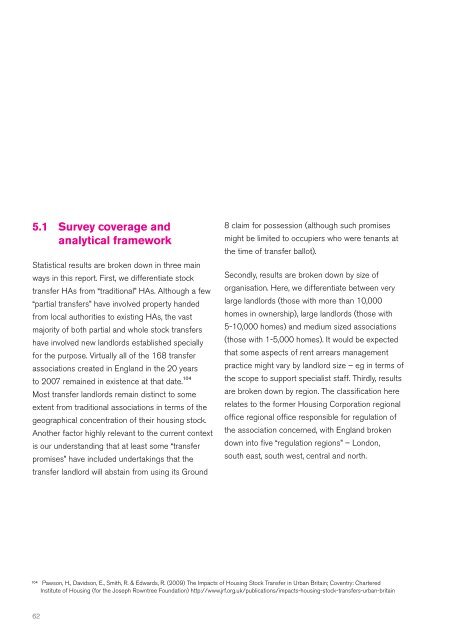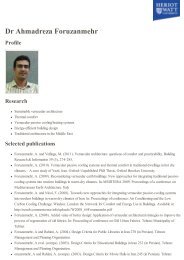Rent arrears management practices in the housing association sector
Rent arrears management practices in the housing association sector
Rent arrears management practices in the housing association sector
Create successful ePaper yourself
Turn your PDF publications into a flip-book with our unique Google optimized e-Paper software.
5.1 Survey coverage and<br />
analytical framework<br />
Statistical results are broken down <strong>in</strong> three ma<strong>in</strong><br />
ways <strong>in</strong> this report . First, we differentiate stock<br />
transfer HAs from “traditional” HAs . Although a few<br />
“partial transfers” have <strong>in</strong>volved property handed<br />
from local authorities to exist<strong>in</strong>g HAs, <strong>the</strong> vast<br />
majority of both partial and whole stock transfers<br />
have <strong>in</strong>volved new landlords established specially<br />
for <strong>the</strong> purpose . Virtually all of <strong>the</strong> 168 transfer<br />
<strong>association</strong>s created <strong>in</strong> England <strong>in</strong> <strong>the</strong> 20 years<br />
to 2007 rema<strong>in</strong>ed <strong>in</strong> existence at that date . 104<br />
Most transfer landlords rema<strong>in</strong> dist<strong>in</strong>ct to some<br />
extent from traditional <strong>association</strong>s <strong>in</strong> terms of <strong>the</strong><br />
geographical concentration of <strong>the</strong>ir hous<strong>in</strong>g stock .<br />
Ano<strong>the</strong>r factor highly relevant to <strong>the</strong> current context<br />
is our understand<strong>in</strong>g that at least some “transfer<br />
promises” have <strong>in</strong>cluded undertak<strong>in</strong>gs that <strong>the</strong><br />
transfer landlord will absta<strong>in</strong> from us<strong>in</strong>g its Ground<br />
62<br />
8 claim for possession (although such promises<br />
might be limited to occupiers who were tenants at<br />
<strong>the</strong> time of transfer ballot) .<br />
Secondly, results are broken down by size of<br />
organisation . Here, we differentiate between very<br />
large landlords (those with more than 10,000<br />
homes <strong>in</strong> ownership), large landlords (those with<br />
5-10,000 homes) and medium sized <strong>association</strong>s<br />
(those with 1-5,000 homes) . It would be expected<br />
that some aspects of rent <strong>arrears</strong> <strong>management</strong><br />
practice might vary by landlord size – eg <strong>in</strong> terms of<br />
<strong>the</strong> scope to support specialist staff . Thirdly, results<br />
are broken down by region . The classification here<br />
relates to <strong>the</strong> former Hous<strong>in</strong>g Corporation regional<br />
office regional office responsible for regulation of<br />
<strong>the</strong> <strong>association</strong> concerned, with England broken<br />
down <strong>in</strong>to five “regulation regions” – London,<br />
south east, south west, central and north .<br />
104 Pawson, H ., Davidson, E ., Smith, R . & Edwards, R . (2009) The Impacts of Hous<strong>in</strong>g Stock Transfer <strong>in</strong> Urban Brita<strong>in</strong>; Coventry: Chartered<br />
Institute of Hous<strong>in</strong>g (for <strong>the</strong> Joseph Rowntree Foundation) http://www .jrf .org .uk/publications/impacts-hous<strong>in</strong>g-stock-transfers-urban-brita<strong>in</strong>




